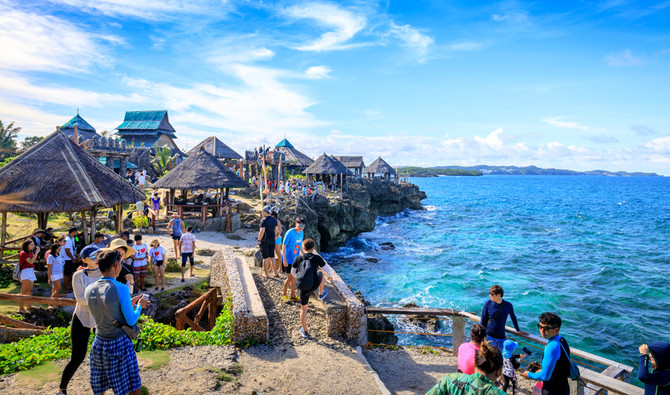Yes, tourism is high in the Philippines. The country attracts millions of tourists annually with its natural beauty and rich culture, contributing significantly to the economy.

The most popular tourist attraction in the Philippines
- Boracay: Known for its white sandy beaches and vibrant nightlife, Boracay is one of the most famous islands in the Philippines. It’s the perfect spot for beach lovers, party-goers, and water sports enthusiasts.
- Palawan: Palawan is home to several UNESCO World Heritage sites, including the Tubbataha Reefs Natural Park and the Puerto Princesa Subterranean River. It’s a paradise for nature lovers and adventurers.
- Chocolate Hills in Bohol: This geological formation, made up of more than 1,000 perfectly cone-shaped hills, is a sight to behold. The hills, which turn chocolate brown during the dry season, are a popular tourist spot in Bohol.
- Intramuros, Manila: Also known as the “Walled City,” Intramuros is the oldest district in Manila. It features Spanish-era architectures and historic sites, making it a must-visit for history buffs.
- Banaue Rice Terraces: Often referred to as the “Eighth Wonder of the World,” the Banaue Rice Terraces are ancient man-made terraces that were carved into the mountains of Ifugao by the indigenous people.
- Mayon Volcano, Albay: Known for its perfect cone shape, Mayon Volcano is a popular spot for hikers and adventure seekers. Its surrounding landscape also offers opportunities for ATV adventures.
- Taal Volcano, Tagaytay: Just a few hours from Manila, Taal Volcano offers a beautiful panoramic view, especially from the city of Tagaytay. It is one of the smallest active volcanoes in the world.
- Cebu City: Often called the “Queen City of the South,” Cebu is rich in history and culture. It’s also a gateway to some of the country’s finest beaches and dive spots.
- Siargao Island: Known as the “Surfing Capital of the Philippines,” Siargao is a haven for surfers and nature lovers. The island is famous for its stunning landscapes and crystal-clear waters.
- Rizal Park, Manila: Also known as Luneta Park, this historical urban park is one of the largest in Asia and is a monument to the Philippine national hero, Jose Rizal. It is often the venue for various events and performances.
Current State of Tourism
The tourism industry in the Philippines has witnessed a dramatic transformation over the years. The country, renowned for its stunning beaches, vibrant festivals, and warm hospitality, has become a major destination for travelers worldwide.
Tourism Statistics
The Philippines has seen a significant rise in both domestic and international tourists. According to the Department of Tourism, the number of foreign visitors reached a record high of over 8 million in 2021. Popular destinations include Boracay, Cebu, Palawan, and Davao, which offer a unique blend of natural beauty and rich culture. The rise in tourist numbers corresponds with increased revenue, contributing significantly to the nation’s economy.
Comparison with Other Countries
When compared to other Southeast Asian countries such as Thailand and Indonesia, the Philippines holds a competitive position. While the former two countries attract a larger number of tourists, the Philippines is fast gaining traction due to its untapped tourism potential and diverse offerings.
Impact of Global Events
Global events such as pandemics and economic crises have an inevitable impact on tourism. The COVID-19 pandemic, for instance, caused a significant dip in international arrivals, affecting the overall tourism industry. However, the Philippines has shown resilience, with the tourism sector gradually rebounding as global travel restrictions ease.

Future of Tourism in the Philippines
The future of tourism in the Philippines looks promising, with emerging trends and innovations, potential challenges and opportunities, and a growing emphasis on sustainability.
Emerging Trends and Innovations
The digital revolution is reshaping the tourism landscape. Innovations such as virtual reality tours, AI-driven personalized travel recommendations, and cashless transactions are expected to enhance the tourist experience. In particular, the rise of ecotourism and adventure tourism opens new avenues for the Philippines to showcase its rich biodiversity and varied terrain.
Challenges and Opportunities
The Philippines faces several challenges, including natural disasters, over-tourism in certain regions, and preserving its cultural heritage. However, these challenges also present opportunities for growth. For instance, sustainable tourism initiatives could turn environmental challenges into assets, while efforts to promote less-known destinations could alleviate overcrowding in popular tourist spots and reveal the country’s hidden gems.
Sustainability Efforts
The Philippine government and tourism stakeholders are increasingly recognizing the importance of sustainable tourism. Policies are being put in place to preserve natural resources and promote responsible tourism. One example is the rehabilitation of Boracay in 2018, which set a precedent for balancing tourism development with environmental preservation.